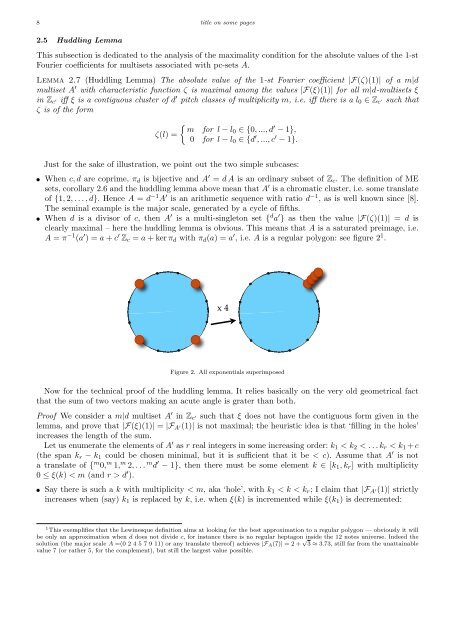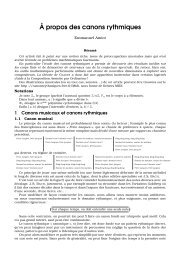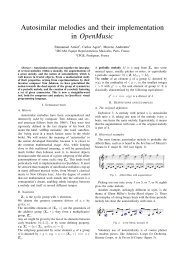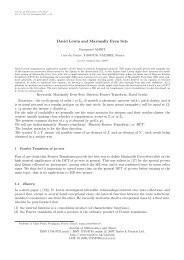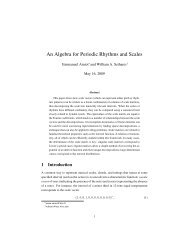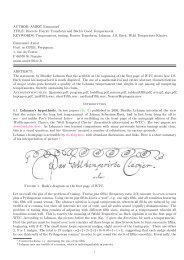Emmanuel Amiot Modèles algébriques et algorithmes pour la ...
Emmanuel Amiot Modèles algébriques et algorithmes pour la ...
Emmanuel Amiot Modèles algébriques et algorithmes pour la ...
You also want an ePaper? Increase the reach of your titles
YUMPU automatically turns print PDFs into web optimized ePapers that Google loves.
8 title on some pages<br />
2.5 Huddling Lemma<br />
This subsection is dedicated to the analysis of the maximality condition for the absolute values of the 1-st<br />
Fourier coefficients for multis<strong>et</strong>s associated with pc-s<strong>et</strong>s A.<br />
Lemma 2.7 (Huddling Lemma) The absolute value of the 1-st Fourier coefficient |F(ζ)(1)| of a m|d<br />
multis<strong>et</strong> A ′ with characteristic function ζ is maximal among the values |F(ξ)(1)| for all m|d-multis<strong>et</strong>s ξ<br />
in Zc ′ iff ξ is a contiguous cluster of d′ pitch c<strong>la</strong>sses of multiplicity m, i.e. iff there is a l0 ∈ Zc ′ such that<br />
ζ is of the form<br />
ζ(l) =<br />
m for l − l0 ∈ {0, ..., d ′ − 1},<br />
0 for l − l0 ∈ {d ′ , ..., c ′ − 1}.<br />
Just for the sake of illustration, we point out the two simple subcases:<br />
• When c, d are coprime, πd is bijective and A ′ = d A is an ordinary subs<strong>et</strong> of Zc. The definition of ME<br />
s<strong>et</strong>s, corol<strong>la</strong>ry 2.6 and the huddling lemma above mean that A ′ is a chromatic cluster, i.e. some trans<strong>la</strong>te<br />
of {1, 2, . . . , d}. Hence A = d −1 A ′ is an arithm<strong>et</strong>ic sequence with ratio d −1 , as is well known since [8].<br />
The seminal example is the major scale, generated by a cycle of fifths.<br />
• When d is a divisor of c, then A ′ is a multi-singl<strong>et</strong>on s<strong>et</strong> { d a ′ } as then the value |F(ζ)(1)| = d is<br />
clearly maximal – here the huddling lemma is obvious. This means that A is a saturated preimage, i.e.<br />
A = π −1 (a ′ ) = a + c ′ Zc = a + ker πd with πd(a) = a ′ , i.e. A is a regu<strong>la</strong>r polygon: see figure 2 1 .<br />
x 4<br />
Figure 2. All exponentials superimposed<br />
Now for the technical proof of the huddling lemma. It relies basically on the very old geom<strong>et</strong>rical fact<br />
that the sum of two vectors making an acute angle is grater than both.<br />
Proof We consider a m|d multis<strong>et</strong> A ′ in Zc ′ such that ξ does not have the contiguous form given in the<br />
lemma, and prove that |F(ξ)(1)| = |FA ′(1)| is not maximal; the heuristic idea is that ‘filling in the holes’<br />
increases the length of the sum.<br />
L<strong>et</strong> us enumerate the elements of A ′ as r real integers in some increasing order: k1 < k2 < . . . kr < k1 + c<br />
(the span kr − k1 could be chosen minimal, but it is sufficient that it be < c). Assume that A ′ is not<br />
a trans<strong>la</strong>te of { m 0, m 1, m 2, . . . m d ′ − 1}, then there must be some element k ∈ [k1, kr] with multiplicity<br />
0 ≤ ξ(k) < m (and r > d ′ ).<br />
• Say there is such a k with multiplicity < m, aka ‘hole’, with k1 < k < kr; I c<strong>la</strong>im that |FA ′(1)| strictly<br />
increases when (say) k1 is rep<strong>la</strong>ced by k, i.e. when ξ(k) is incremented while ξ(k1) is decremented:<br />
1 This exemplifies that the Lewinesque definition aims at looking for the best approximation to a regu<strong>la</strong>r polygon — obviously it will<br />
be only an approximation when d does not divide c, for instance there is no regu<strong>la</strong>r heptagon inside the 12 notes universe. Indeed the<br />
solution (the major scale A =(0 2 4 5 7 9 11) or any trans<strong>la</strong>te thereof) achieves |FA(7)| = 2 + √ 3 ≈ 3.73, still far from the unattainable<br />
value 7 (or rather 5, for the complement), but still the <strong>la</strong>rgest value possible.


